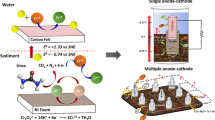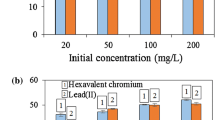Abstract
The microbial desalination cell (MDC) is a bio-electrochemical system that exhibits the ability to oxidize organic compounds, produce energy, and decrease the saline concentrations within the desalination chamber. The selective removal of ions from the desalination chamber is significantly influenced by the anion and cation exchange membranes. In this study, a three-chamber microbial desalination cell was developed to treat seawater using a synthesize Fe3O4 magnetite nanoparticle (MNP)-modified anode. The impact of different performance parameters, such as temperature, pH, and concentrations of NPs, has been investigated in order to assess the performance of three-chamber MDCs in terms of energy recovery and salt removal. The evaluation criteria of the system included multiple factors such as chemical oxygen demand (COD), Coulombic efficiency (CE), desalination efficiency, as well as system aspects including voltage generation and power density. The highest COD% removal efficiency was 74% at 37 °C, pH = 7, and 30 g/L salt concentration with an optimized NPs concentration of 2.0 mg/cm2 impregnated on anode. The maximum Coulombic efficiency was 10.3% with the maximum power density of 4.3 W/m3. The effect of the nanoparticle concentration impregnated on the anode was clarified by the primary factor of analysis. This research has revealed consistent patterns in the enhancement of voltage generation, COD, and Coulombic efficiencies when incorporating higher concentrations of nanoparticles on the anode at a certain point.








Similar content being viewed by others
Data Availability
Not applicable.
References
Zahid, M., Savla, N., Pandit, S., Thakur, V. K., Jung, S. P., Gupta, P. K., … Marsili, E. (2022). Microbial desalination cell: Desalination through conserving energy. Desalination, 521, 115381. https://doi.org/10.1016/j.desal.2021.115381
Liaquat, R., mehmood, Khoja, A., Iqbal, N., Ejaz, H., & Mumtaz, S. (2021). Investigating the potential of locally sourced wastewater as a feedstock of microbial desalination cell (MDC) for bioenergy production. Bioprocess and Biosystems Engineering, 44. https://doi.org/10.1007/s00449-020-02433-2
Madondo, N. I., Rathilal, S., Bakare, B. F., & Tetteh, E. K. (2023). Application of bioelectrochemical systems and anaerobic additives in wastewater treatment: A conceptual review. International Journal of Molecular Sciences, 24(5), 4753. https://doi.org/10.3390/ijms24054753
Topcu, Ş., & Taşkan, E. (2021). Effect of the tetracycline antibiotics on performance and microbial community of microbial fuel cell. Bioprocess and Biosystems Engineering, 44(3), 595–605. https://doi.org/10.1007/s00449-020-02473-8
Elawwad, A., Ragab, M., Hamdy, A., & Husein, D. (2020). Enhancing the performance of microbial desalination cells using δMnO2/graphene nanocomposite as a cathode catalyst. Journal of Water Reuse and Desalination, 10. https://doi.org/10.2166/wrd.2020.011
Alhimali, H., Jafary, T., Al-Mamun, A., Baawain, M. S., & Vakili-Nezhaad, G. R. (2019). New insights into the application of microbial desalination cells for desalination and bioelectricity generation. Biofuel Research Journal, 6(4), 1090–1099. https://doi.org/10.18331/BRJ2019.6.4.5
Gujjala, L. K. S., Dutta, D., Sharma, P., Kundu, D., Vo, D. V. N., & Kumar, S. (2022). A state-of-the-art review on microbial desalination cells. Chemosphere, 288, 132386. https://doi.org/10.1016/j.chemosphere.2021.132386
Safwat, S. M., Meshref, M. N. A., Salama, M., & Elawwad, A. (2023). Influence of co-substrate existence, temperature, pH, and salt concentration on phenol removal, desalination, and power generation using microbial desalination cells. International Journal of Environmental Science and Technology, 20(10), 10695–10712. https://doi.org/10.1007/s13762-022-04731-6
Gude, V. G., Kokabian, B., & Gadhamshetty, V. (n.d.). Beneficial bioelectrochemical systems for energy, water, and biomass production. Journal of Microbial & Biochemical Technology, 0(0), 1–14. https://doi.org/10.4172/1948-5948.S6-005
Zamora, P., Ortiz, J. M., Ramirez-Moreno, M., Rodenas, P., Aliaguilla, M., Bosch-Jimenez, P., … Esteve-Núñez, A. (2019). Comparative performance of microbial desalination cells using air diffusion and liquid cathode reactions: Study of the salt removal and desalination efficiency. Frontiers in Energy Research, 135.
Sacco, N. J., Bonetto, M. C., & Cortón, E. (2017). Isolation and characterization of a Novel Electrogenic Bacterium, Dietzia sp. RNV-4. Plos One, 12(2), e0169955. https://doi.org/10.1371/journal.pone.0169955
Malvankar, N. S., & Lovley, D. R. (2014). Microbial nanowires for bioenergy applications. Current Opinion in Biotechnology, 27, 88–95. https://doi.org/10.1016/j.copbio.2013.12.003
Pietrasanta, A. M., Mussati, S. F., Aguirre, P. A., Morosuk, T., & Mussati, M. C. (2022). Optimization of a multi-generation power, desalination, refrigeration and heating system. Energy, 238, 121737. https://doi.org/10.1016/j.energy.2021.121737
Zhuang, L., Zhang, W., Zhao, Y., Shen, H., Lin, H., & Liang, J. (2015). Preparation and characterization of Fe3O4 particles with novel nanosheets morphology and Magnetochromatic Property by a modified Solvothermal Method. Scientific Reports, 5(1), 9320. https://doi.org/10.1038/srep09320
Kumar, A., Sharma, K., Pandit, S., Singh, A., & Prasad, R. (2023). Evaluation of the algal-derived biochar as an anode modifier in microbial fuel cells. Bioresource Technology Reports, 22, 101414. https://doi.org/10.1016/j.biteb.2023.101414
Sharma, K., Pandit, S., Singh, A., Gupta, P., Pant, K., & Jadhav, D. (2023). Microbial Electrochemical Treatment of Methyl Red Dye Degradation using co-culture method. Water, 15, 1–18. https://doi.org/10.3390/w15010056
Kumar, A., Siddiqui, T., Pandit, S., Roy, A., Gacem, A., Souwaileh, A., … Park, H.-K. (2023). Application of biogenic TiO2 nanoparticles as ORR catalysts on cathode for enhanced performance of microbial fuel cell. Catalysts, 13, 937. https://doi.org/10.3390/catal13060937
Ebrahimi, A., Yousefi Kebria, D., & Najafpour, G. (2017). Improving bioelectricity generation and COD removal of sewage sludge in microbial desalination cell. Environmental Technology, 39, 1–28. https://doi.org/10.1080/09593330.2017.1323958
Rodriguez-Caballero, A., Ramond, J. B., Welz, P., Cowan, D., Odlare, M., & Burton, S. (2012). Treatment of high ethanol concentration wastewater by biological sand filters: Enhanced COD removal and bacterial community dynamics. Journal of Environmental Management, 109, 54–60. https://doi.org/10.1016/j.jenvman.2012.05.005
Mountcastle, S., Vyas, N., Villapun, V., Cox, S., Jabbari, S., Sammons, R., … Kuehne, S. (2021). Biofilm viability checker: An open-source tool for automated biofilm viability analysis from confocal microscopy images. npj Biofilms and Microbiomes, 7. https://doi.org/10.1038/s41522-021-00214-7
Wei, Y., Han, B., Hu, X., Lin, Y., Wang, X., & Deng, X. (2012). Synthesis of Fe3O4 nanoparticles and their magnetic properties. Procedia Engineering, 27, 632–637. https://doi.org/10.1016/j.proeng.2011.12.498
Aiyer, K. S. (2021). Synergistic effects in a microbial fuel cell between co-cultures and a photosynthetic alga Chlorella vulgaris improve performance. Heliyon, 7(1), e05935. https://doi.org/10.1016/j.heliyon.2021.e05935
Cao, X., Huang, X., Liang, P., Xiao, K., Zhou, Y., Zhang, X., & Logan, B. E. (2009). A new method for water desalination using microbial desalination cells. Environmental Science & Technology, 43(18), 7148–7152. https://doi.org/10.1021/es901950j
Jacobson, K. S., Drew, D. M., & He, Z. (2011). Use of a liter-scale microbial desalination cell as a platform to study bioelectrochemical desalination with salt solution or artificial seawater. Environmental Science & Technology, 45(10), 4652–4657. https://doi.org/10.1021/es200127p
Zhang, B., & He, Z. (2012). Integrated salinity reduction and water recovery in an osmotic microbial desalination cell. RSC Advances, 2(8), 3265–3269. https://doi.org/10.1039/C2RA20193C
Chen, S., Liu, G., Zhang, R., Qin, B., Luo, Y., & Hou, Y. (2012). Improved performance of the microbial electrolysis desalination and chemical-production cell using the stack structure. Bioresource Technology, 116, 507–511. https://doi.org/10.1016/j.biortech.2012.03.073
Qu, Y., Feng, Y., Liu, J., He, W., Shi, X., Yang, Q., … Logan, B. E. (2013). Salt removal using multiple microbial desalination cells under continuous flow conditions. Desalination, 317, 17–22. https://doi.org/10.1016/j.desal.2013.02.016
Jafary, T., Al-Mamun, A., Alhimali, H., Baawain, M. S., Rahman, S., Tarpeh, W. A., … Kim, B. H. (2020). Novel two-chamber tubular microbial desalination cell for bioelectricity production, wastewater treatment and desalination with a focus on self-generated pH control. Desalination, 481, 114358. https://doi.org/10.1016/j.desal.2020.114358
Acknowledgements
The authors extend their appreciation to Taif university, Saudi Arabia, for supporting this work through project number (TU-DSPP-2024-02).
Funding
The research was funded by Taif University, Saudi Arabia, Project No. (TU-DSPP-2024-02).
Author information
Authors and Affiliations
Contributions
SP and AR conceptualized work. AK, SS, SP, and AR designed and wrote the initial manuscript draft. DL, SA, MA, AAA, and MA prepared the figures and tables, edited, and revised the manuscript critically. The final manuscript has been approved by all the authors.
Corresponding author
Ethics declarations
Ethical Approval
Not applicable.
Consent to Participate
Not applicable.
Consent for Publication
Not applicable.
Competing Interests
The authors declare no competing interests.
Additional information
Publisher’s Note
Springer Nature remains neutral with regard to jurisdictional claims in published maps and institutional affiliations.
Rights and permissions
Springer Nature or its licensor (e.g. a society or other partner) holds exclusive rights to this article under a publishing agreement with the author(s) or other rightsholder(s); author self-archiving of the accepted manuscript version of this article is solely governed by the terms of such publishing agreement and applicable law.
About this article
Cite this article
Singh, S., Kumar, A., Pandit, S. et al. Utilizing a Fe3O4 Magnetite Nanoparticle for Anode Modification in a Microbial Desalination Cell to Treat Saltwater. Appl Biochem Biotechnol (2024). https://doi.org/10.1007/s12010-024-04925-3
Accepted:
Published:
DOI: https://doi.org/10.1007/s12010-024-04925-3




